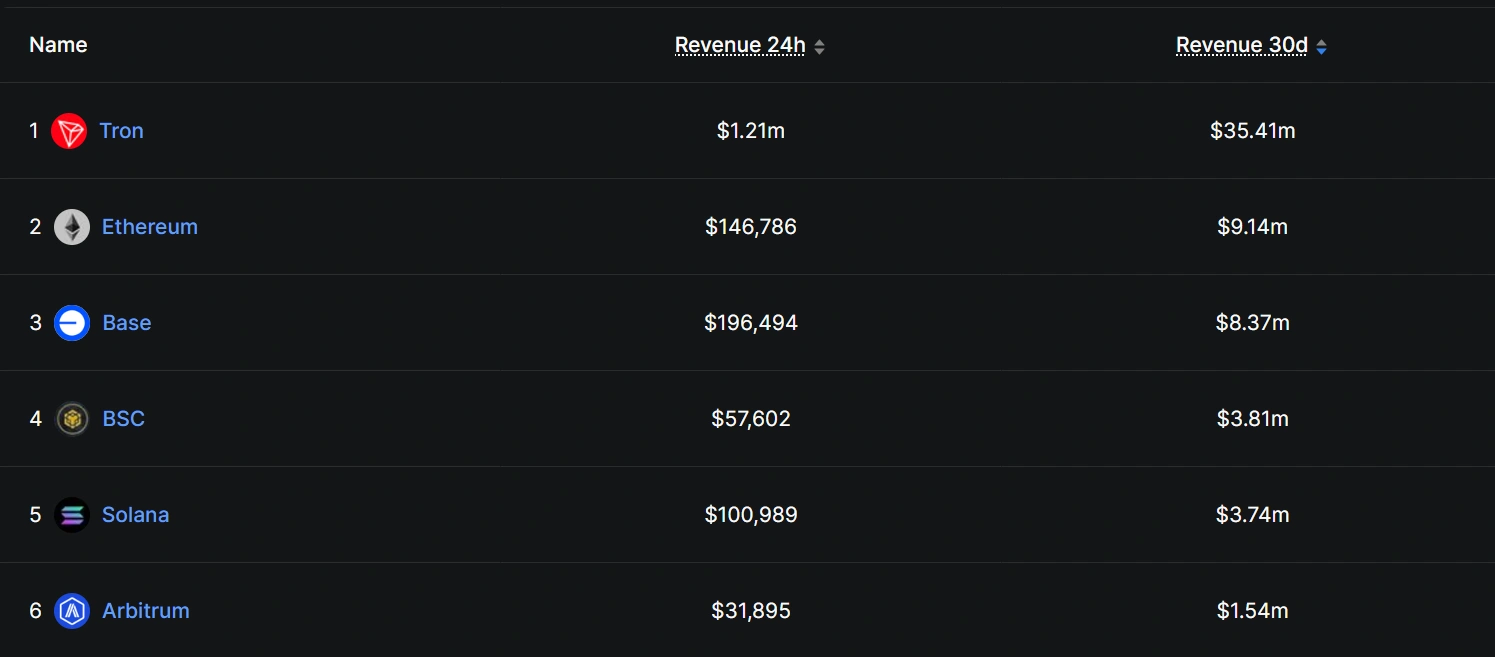Tron leads as the highest-earning blockchain with $35.4 million in protocol revenue over the past 30 days, nearly four times Ethereum’s $9.1 million, driven by robust stablecoin activity and high transaction throughput on the network.
-
Tron tops blockchain revenue charts with $35.4 million in the last 30 days, surpassing all competitors.
-
Ethereum ranks second at $9.1 million, highlighting Tron’s efficient fee capture model.
-
Recent 24-hour data shows Tron at $1.21 million, with Base, Ethereum, and Solana trailing behind.
Tron blockchain revenue hits $35.4M in 30 days, outpacing Ethereum by nearly 4x. Uncover how stablecoins fuel this lead and what it means for crypto networks. Dive in for key insights today.
What is Driving Tron’s Blockchain Revenue Lead?
Tron blockchain revenue has surged to the forefront, generating $35.4 million in protocol fees over the past 30 days according to DefiLlama data, outstripping Ethereum’s $9.1 million by a factor of nearly four. This dominance stems from Tron’s optimized infrastructure for high-volume transactions, particularly in stablecoins, which account for a significant portion of its activity. In the last 24 hours alone, Tron earned $1.21 million, maintaining its edge over rivals like Base at $196,494 and Ethereum at $146,786.
According to the 30-day revenue data available on DefiLlama, Tron is the highest-earning blockchain network, generating $35.4 million in protocol revenue, nearly four times Ethereum’s $9.1 million, which comes second.
Base came third with $8.37 million in revenue, while BSC ranked fourth with $3.81 million, with Solana following it closely at $3.74 million in revenue.
Also, over the past 24 hours alone, Tron has generated $1.21 million in revenue, maintaining its lead over all other major chains.
Base comes second with $196,494. Ethereum and Solana come third and fourth with $146,786 and $100,989, respectively, within the past 24 hours.
The numbers speak to the strength of Tron’s economic model, which has quietly become one of the most profitable networks in crypto through its focus on high transaction throughput and stablecoin activity.
 Tron leads networks in terms of revenue generated in the last day and 30-day period. Source: Defillama
Tron leads networks in terms of revenue generated in the last day and 30-day period. Source: DefillamaHow is Stablecoin Activity Boosting Tron’s Position?
Tron was initially viewed as another smart contract platform competing with Ethereum. However, over the years, it has risen to become a major backbone of global stablecoin settlements. In 2024, Tron generated $2.15 billion in total fees, second only to Ethereum’s $2.48 billion, according to data from CoinGecko, and based on this year’s data, Tron is already leading. The blockchain leads in the stablecoin market and controls most of Tether’s USDT transactions, accounting for around half its market capitalization and over 55% of its transaction volume.
World Liberty Financial’s stablecoin, USD1, was launched on Tron, adding to the platform’s increasing list of stablecoins. The network is also relatively popular in emerging markets and centralized exchanges, thanks to increased USDT adoption, and this has greatly contributed to it earning more revenues than any other blockchain. Experts note that Tron’s low-cost, high-speed environment makes it ideal for everyday stablecoin transfers, which accumulate into substantial protocol fees. For instance, financial analyst reports from Artemis highlight how such activity has stabilized Tron’s revenue streams amid volatile crypto markets.
Why Does Ethereum Trail Despite Its Ecosystem Strength?
Ethereum is still the largest and most diverse smart contract network, hosting the bulk of decentralized finance (DeFi) projects globally. However, its lower transaction count and higher reliance on scaling layer-2 networks like Arbitrum, Optimism, Base, and Polygon, among others, mean that protocol-level fee capture has become less concentrated on its base layer.
Tron’s design, on the other hand, sees to it that nearly all on-chain activity, including stablecoin transfers and resource delegation, directly feeds into protocol revenue, and this explains why the margin its 30-day revenue figure gave Ethereum is about 3.8 times.
However, Ethereum continues to lead in terms of total value locked (TVL) and developer activity. Data from Dune Analytics shows Ethereum’s TVL exceeding $50 billion, underscoring its foundational role in DeFi. Blockchain researcher Chris Burniske has commented that while Ethereum’s multi-layer approach fosters innovation, it dilutes base-layer revenues, a trade-off Tron avoids through its centralized efficiency.
What Role Does Market Differentiation Play in Blockchain Revenue?
The appeal of Tron to users lies in speed and cost; however, platforms like Solana are also gaining popularity for those two qualities as well.
For Tron, each of those small transfers adds up. As stablecoin adoption continues to grow globally, especially in regions like Asia and Latin America, the network seems positioned to remain a primary beneficiary.
For Ethereum, which still leads in infrastructure and innovation, the challenge will be making sure that its value capture mechanisms move in tandem with its expanding ecosystem of layer-2 networks. Comparative analyses from Messari indicate that Tron’s focus on transactional efficiency has captured over 40% of global stablecoin volume, a metric that directly correlates with its revenue superiority.
Frequently Asked Questions
What Makes Tron the Highest-Earning Blockchain in Recent Data?
Tron achieved $35.4 million in 30-day protocol revenue through its dominance in stablecoin transactions, particularly USDT, which drives high-volume, low-cost activity. DefiLlama reports confirm this lead, attributing it to Tron’s efficient model that captures fees from nearly all on-chain operations, outpacing Ethereum by a wide margin.
How Does Tron’s Revenue Compare to Solana and Base in the Last 24 Hours?
In the past 24 hours, Tron generated $1.21 million, far ahead of Base’s $196,494 and Solana’s $100,989. This edge comes from sustained stablecoin usage, making Tron’s network a go-to for quick, affordable transfers in emerging markets, as reflected in real-time DefiLlama metrics.
Key Takeaways
- Tron’s Revenue Dominance: With $35.4 million in 30 days, Tron showcases how stablecoin focus can eclipse broader ecosystems like Ethereum.
- Stablecoin Impact: Over 55% of USDT volume on Tron fuels consistent fees, positioning it as a leader in global settlements.
- Future Implications: As adoption grows in emerging regions, networks optimizing for speed and cost may continue to capture more value.
Conclusion
In summary, Tron blockchain revenue stands at the pinnacle with $35.4 million over 30 days, propelled by stablecoin activity that outshines Ethereum’s diverse but diluted fee structure. This differentiation underscores the evolving landscape of blockchain economics, where efficiency meets high throughput. As stablecoin integration deepens worldwide, Tron’s model offers a blueprint for sustainable profitability—explore these trends to stay ahead in the crypto space.
